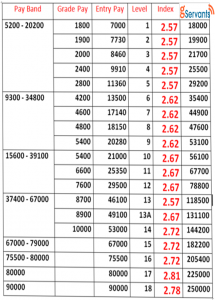Central Govt employees expect increase in the Fitment Factor recommended by 7th CPC
The demand to increase the 2.57 Fitment Factor along with the hike of 14.29 percent is growing among the Central Government employees
The 900-page long report of the 7th Pay Commission was submitted to the government on November 19. One of the most important recommendation on the report is the Fitment Factor. It is the most important factor deciding the hike of salaries of the Central Government employees.
Fitment Factor is used to calculate the revised basic pay of existing employees with effect from the implementation of 7th CPC. The new revised basic pay of a Central Government employee is calculated by multiplying his/her current (Pre-revised) basic pay with the Fitment Factor.
MUST READ : Bunching benefit in Pay fixation is recommended by 7th pay commission in some situation
The 7th Pay Commission has recommended a uniform Fitment Factor of 2.57 for all. The actual raise/fitment recommended by the Commission is 14.29 percent only. The report says that the fitment includes a factor of 2.25 on account of DA neutralisation, assuming that the rate of D.A. would be 125 percent at the time of implementation of the new pay.
The 7th Pay Commission has evolved a new pay fitment table by merging the existing Grade Pay and Pay Bands for all group of Central Government employees, which is called as Pay Matrix Table. The Pay Matrix comprises two dimensions. It has a “horizontal range” in which each level corresponds to a ‘functional role in the hierarchy’ and has been assigned the numbers 1, 2, 3, and so on till 18. The “vertical range” for each level denotes ‘pay progression’ within that level. These indicate the steps of annual financial progression of three percent within each level. The starting point of the matrix is the minimum pay which has been arrived based on 15th Indian Labour Congress (ILC) norms or the Aykroyd formula.

On recruitment, an employee joins at a particular level and progresses within the level as per the vertical range. The movement is usually on an annual basis, based on annual increments till the time of their next promotion. When the employee receives a promotion or a non-functional financial upgrade, he/she progresses one level ahead on the horizontal range.
The Pay Matrix chart has included a number of Fitment Factors. 6 types of Fitment Factor, including 2.57, 2.62, 2.67, 2.72, 2.78, and 2.81, have been listed. Under the heading of ‘Index,’ all the Central Government employees have been divided into 18 categories. Since different Fitment Factors have been used for all these categories, it leads one to believe that the new factor will apply for the existing employees too.
Criticism has come from all the circles over the addition of a mere 14.29%, leading to 2.57, while the employees were currently drawing a dearness allowance of 125% of their basic pay. The minimum wages have been decided on this criterion alone (the 6th Pay Commission had fixed the minimum wages as Rs.7000. The 7th CPC minimum wages of 18,000 has been arrived at by multiplying the previous number by 2.57).
One might remember that similar requests were presented at the time of the 6th Pay Commission too. The commission had recommended the Fitment Factor of 1.74, but, due to constant pressure from the NC JCM Staff Side members, it was increased to 1.86. The demand to increase the 2.57 Fitment Factor along with the 14.29 percent hike is growing among the Central Government employees.
Source : 7thpaycommissionnews.in

The fitment factor has been revised for all n comes to 2.67 but people who are in grade of 37000/= to 67000/= with GP 8700/= are getting only 2.57. Why this discrimination.If you see the fitment factor will observe this as observed by me. Something should be done to get it increased to the same fitment factor as are for lower grade n upper grade Grade pay.This is for information.AKBhatnagar